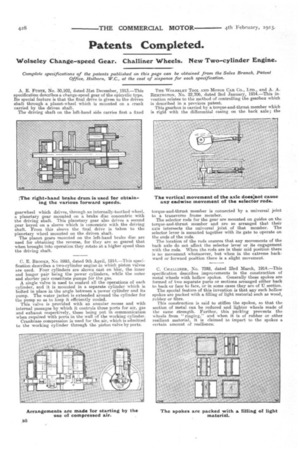Patents Completed.
Page 22

If you've noticed an error in this article please click here to report it so we can fix it.
Wolseley Change-speed Gear. Challiner Wheels. New Two-cylinder Engine.
Complete specifications of the patents published on this page can be obtained from the Sales Branch, Patent Office, Holborn, W.C., at the cost of sixpence for each specification.
A. E. FIISTE, NO. 30,102, dated 31st December, 1913.—This specification describes a change-speed gear of the epicyclic type. Its special feature is that the final drive is given to the driven shaft through a planet-wheel which is mounted on a crank carried by the driven shaft.
The driving shaft on the left-hand side carries first a fixed gearwheel which drives, through an internally-toothed wheel, a planetary gear mounted on a brake disc concentric with the driving shaft. This planetary gear also drives a second gear keyed on a sleeve which is concentric with the driving shaft. From this sleeve the final drive is taken to the planetary wheel mounted on the driven shaft. The planet gears mounted on the left-hand brake disc are used for obtaining the reverse, for they are so geared that when brought into operation they rotate at a higher speed than the driving shaft.
C. E. BROOKS, No. 8993, dated 9th April., 1914.—This specification describes a two-cylinder engine in which piston valves are used. Four cylinders are shown east en bloc, the inner and longer pair being the power cylinders, while the outer and shorter pair constitute pumps for the gas.
A single valve is used to control all the operations of each cylinder, and it is mounted in a. separate cylinder which is bolted in place in the angle between a power cylinder and its pump. The water jacket is extended around the cylinder for the pump so as to keep it efficiently cooled.
This valve is provided with an annular recess and with internal passages by which it controls three ports for air, as and exhaust respectively, these being put in communication when requited with ports in the wall of the working cylinder.
Crankcase compression is used for the, air, which is admitted to the working cylinder through the piston valve by ports.
THE WOLSELEY TOOL AND MOTOR CAR CO., LTD., and A. A. REMINGTON, No. 22,706, dated 2nd January, 1914.—This invention relates to the method of controlling the gearbox which is described in a previous patent. This gearbox is carried by a torque-and-thrust member which is rigid with the differential casing on the back axle; the
torque-and-thrust member is connected by a universal joint to a transverse frame member.
The selector rods for the gear are mounted on guides on the torque-and-thrust member and are so arranged that their axis intersects the universal joint of that member. The selector lever is mounted together with its gate to operate on the ends of the rods.
The location of the rods ensures that any movements of the back axle do not affect the selector lever or its engagement with the rods. When the rods are in their mid position there is no movement whatsoever, but when in the extreme backward or forward position there is a slight movement.
C. CHALLINER, No. 7248, dated 23rd March, 1914.—This specification describes improvements in the construction of metal wheels with hollow spokes. Generally these spokes are formed of two separate parts or sections arranged either back to back or face to face, or in some cases they are of U section.
The special feature of this invention is that any such hollow spokes are packed with a filling of light material such as wood, rubber or fibre.
rniK construction is said to stiffen the spokes, so that the section of metal can be reduced and lighter wheels made of the same strength. Further, this packing prevents the wheels from "ringing," and when it is of rubber or other resilient material, it is claimed to impart to the spokes a certain amonnt of resilience.






















